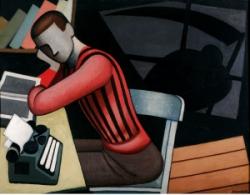From the bullfighting era to the Moncada Barracks: new MMFA exhibition explores a century of Cuban history in pictures
- Submitted by: admin
- Arts and Culture
- Caribbean
- Culture and Traditions
- Events
- Havana
- History
- International
- North America
- Paint and Sculpture
- Personalities
- 02 / 18 / 2008

The exhibition has enjoyed significant popularity since it opened. According to Nathalie Bondil, the general curator of the exhibition, it has been even more popular than the last years Once Upon a Time: Walt Disney.
Ordered chronologically, the exhibition traces Cubas history from 1868 onward. It is clear, as soon as you enter the gallery, that Europes influence was still strong in the later 19th century. Cuba was a Spanish colony up until 1901, and the colonial influence is evident in paintings of the time. Cuba adopted European artistic movements like impressionism; Domingo Ramos was the islands resident Monet.
At the exhibitions beginning, Cuban identity is presented as synonymous with Spanish identity - the perspectives of slaves or anti-colonialists are not present in the art. But as you walk along you see a more multi-faceted national identity starting to develop, through painting, photography, sculpture, film, and music. In the first few decades of the 20th century, Joaquín Blezs photography captures the decadence of upper class Cuba, while Walker Evans takes a look at the other side of society: the grittier, violent side inspired by the reign of the dictator Gerardo Machado.
It wasnt until the Revolution of 1959 that Cuba made a definitive break from foreign domination. For the most part, the paintings and photographs on display glorify the movement. This section houses the Heroic Guerrilla, the iconic photograph of Che Guevara taken, almost by accident, by Alberto Korda. At the time, Che was standing behind Castro who was delivering a public speech; consequently, Korda wasnt focusing on the young revolutionary. For a moment, Che stepped forward and looked at the crowd. Korda took two shots before Che withdrew into the background. The whole thing took about 30 seconds, but it resulted in what is reputedly the most reproduced image in history.
After the 1950s, artists used an array of media to express post-revolutionary identity. Installations abound, along with film productions, photography, and sculptures. The Communist regime isnt directly addressed in these works; however, Cuban art is so inextricably linked to its political situation that its hard to lose sight of when viewing abstract sculptures made from mud and sand.
The sections flow together, creating a dynamic and sometimes overwhelming crash course in Cuban art. Bondil argues that "the artists in Cuba are always involved in the society - art is a tool, a weapon, it is [a force] for education." This statement, more than the art itself, describes the paradox of Cuban identity. Art may be a weapon, but if it rarely leaves the country, how does it form an audible voice? The exhibit certainly provides the viewer with a portrait of a Cuba. This Cuba is beautiful and changing, but there are obviously other Cubas that are not put on display.
(www.mcgilldaily.com)
Ordered chronologically, the exhibition traces Cubas history from 1868 onward. It is clear, as soon as you enter the gallery, that Europes influence was still strong in the later 19th century. Cuba was a Spanish colony up until 1901, and the colonial influence is evident in paintings of the time. Cuba adopted European artistic movements like impressionism; Domingo Ramos was the islands resident Monet.
At the exhibitions beginning, Cuban identity is presented as synonymous with Spanish identity - the perspectives of slaves or anti-colonialists are not present in the art. But as you walk along you see a more multi-faceted national identity starting to develop, through painting, photography, sculpture, film, and music. In the first few decades of the 20th century, Joaquín Blezs photography captures the decadence of upper class Cuba, while Walker Evans takes a look at the other side of society: the grittier, violent side inspired by the reign of the dictator Gerardo Machado.
It wasnt until the Revolution of 1959 that Cuba made a definitive break from foreign domination. For the most part, the paintings and photographs on display glorify the movement. This section houses the Heroic Guerrilla, the iconic photograph of Che Guevara taken, almost by accident, by Alberto Korda. At the time, Che was standing behind Castro who was delivering a public speech; consequently, Korda wasnt focusing on the young revolutionary. For a moment, Che stepped forward and looked at the crowd. Korda took two shots before Che withdrew into the background. The whole thing took about 30 seconds, but it resulted in what is reputedly the most reproduced image in history.
After the 1950s, artists used an array of media to express post-revolutionary identity. Installations abound, along with film productions, photography, and sculptures. The Communist regime isnt directly addressed in these works; however, Cuban art is so inextricably linked to its political situation that its hard to lose sight of when viewing abstract sculptures made from mud and sand.
The sections flow together, creating a dynamic and sometimes overwhelming crash course in Cuban art. Bondil argues that "the artists in Cuba are always involved in the society - art is a tool, a weapon, it is [a force] for education." This statement, more than the art itself, describes the paradox of Cuban identity. Art may be a weapon, but if it rarely leaves the country, how does it form an audible voice? The exhibit certainly provides the viewer with a portrait of a Cuba. This Cuba is beautiful and changing, but there are obviously other Cubas that are not put on display.
(www.mcgilldaily.com)
Comments